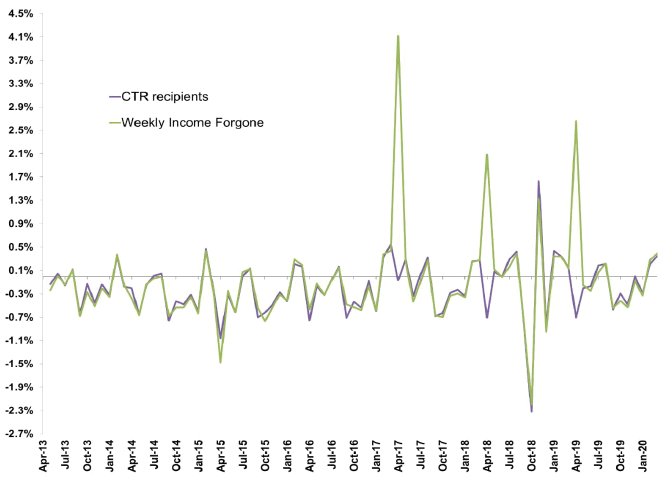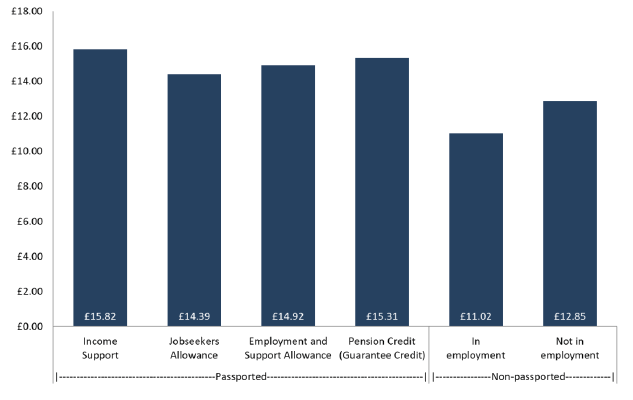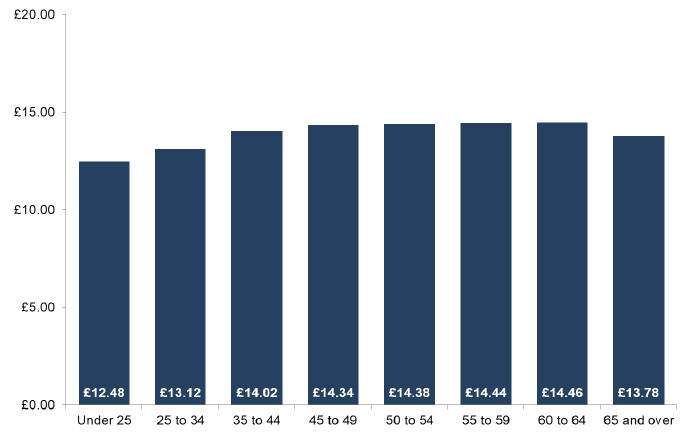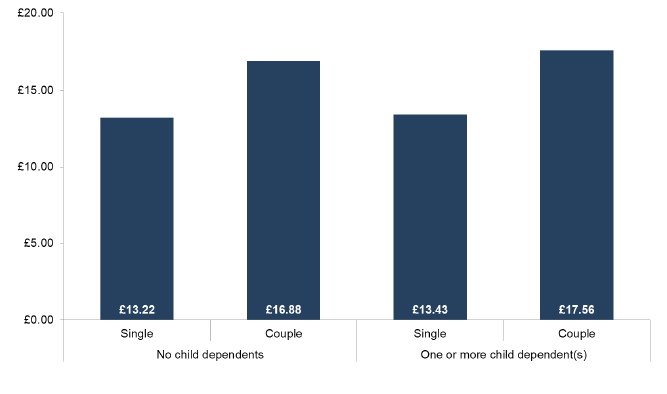Council Tax Reduction in Scotland 2019-2020
Council Tax Reduction (CTR) awarded by age, household structure, income sources and employment status, the deprivation index, and Council Tax band in the financial year from April 2019 till March 2020.
3. Weekly Income Forgone Estimates
The CTR scheme reduces the amount of Council Tax a local authority can expect to receive, although the Scottish Government provides funding to each local authority to reflect that their Council Tax income is lower due to CTR. Weekly income forgone figures are reported quarterly and the following section provides the most recent data. The weekly income forgone estimates are based on the number of CTR recipients multiplied by the average weekly CTR amount per recipient for each local authority and benefit type for the given month. When a household's Council Tax liability is reduced due to the CTR scheme, it reduces the amount of Council Tax a local authority can collect.
The total Council Tax weekly income forgone due to CTR was £6.525 million in March 2020, a marginal increase of 0.7 per cent over this quarter. This rise is in line with previous seasonal trends of a marginal rise in CTR recipients between January and March. A breakdown of the total weekly income forgone by each local authority in January, February and March 2020 is shown in Table 3. It can be seen that Glasgow City accounted for one-fifth (20 per cent) of the total weekly income forgone for Scotland followed by City of Edinburgh (7 per cent) and North Lanarkshire (7 per cent) in March 2020. This is consistent with the higher numbers of CTR recipients recorded for these local authorities.
| Jan-20 | Feb-20 | Mar-20 | % Change (Jan-Mar 20) |
|
|---|---|---|---|---|
| Scotland | 6,481.2 | 6,499.2 | 6,524.8 | 0.7% |
| Aberdeen City | 193.7 | 194.5 | 195.6 | 1.0% |
| Aberdeenshire | 161.0 | 162.2 | 164.6 | 2.2% |
| Angus | 102.5 | 103.6 | 104.5 | 1.9% |
| Argyll and Bute | 100.9 | 101.3 | 102.1 | 1.3% |
| City of Edinburgh | 474.9 | 480.6 | 478.9 | 0.9% |
| Clackmannanshire | 66.4 | 66.6 | 67.1 | 1.0% |
| Dumfries and Galloway | 172.6 | 173.7 | 174.1 | 0.9% |
| Dundee City | 230.1 | 229.7 | 231.2 | 0.5% |
| East Ayrshire | 174.4 | 174.6 | 175.0 | 0.3% |
| East Dunbartonshire | 88.0 | 87.8 | 89.7 | 2.0% |
| East Lothian | 97.4 | 97.6 | 97.6 | 0.3% |
| East Renfrewshire | 68.7 | 68.7 | 69.3 | 0.9% |
| Falkirk | 153.0 | 153.3 | 153.6 | 0.4% |
| Fife | 385.4 | 385.8 | 388.1 | 0.7% |
| Glasgow City | 1,324.8 | 1,327.3 | 1,329.6 | 0.4% |
| Highland | 233.7 | 234.6 | 235.5 | 0.8% |
| Inverclyde | 128.8 | 128.1 | 128.0 | -0.6% |
| Midlothian | 93.0 | 93.0 | 92.9 | -0.1% |
| Moray | 71.6 | 72.0 | 72.5 | 1.2% |
| Na h-Eileanan Siar | 25.9 | 25.9 | 26.0 | 0.6% |
| North Ayrshire | 228.1 | 227.7 | 230.3 | 1.0% |
| North Lanarkshire | 442.3 | 440.2 | 443.1 | 0.2% |
| Orkney Islands | 15.7 | 15.5 | 15.9 | 1.4% |
| Perth and Kinross | 117.7 | 118.6 | 118.5 | 0.7% |
| Renfrewshire | 249.5 | 248.4 | 249.2 | -0.1% |
| Scottish Borders | 102.9 | 106.0 | 105.3 | 2.3% |
| Shetland Islands | 13.2 | 13.6 | 13.3 | 0.9% |
| South Ayrshire | 156.1 | 156.9 | 156.1 | 0.0% |
| South Lanarkshire | 377.5 | 378.8 | 381.6 | 1.1% |
| Stirling | 79.6 | 79.5 | 79.5 | -0.1% |
| West Dunbartonshire | 161.4 | 161.2 | 162.3 | 0.5% |
| West Lothian | 190.5 | 191.9 | 193.4 | 1.5% |
1 Recipients are as at monthly count date. See Methodology Notes, Section 2 for more details. Available at https://www.gov.scot/publications/council-tax-reduction/
2 Weekly income forgone estimates are based on the number of CTR recipients multiplied by the average weekly CTR amount per recipient for each local authority and benefit type for the given month.
3 Figures are rounded to the nearest £100. Components may not sum to total due to rounding. Percentage change are based on unrounded figures.3.1 Weekly income forgone over time
3.1 Weekly income forgone over time
The total weekly income forgone estimates for Scotland (see section 5 for more details) has decreased from £7.092 million in April 2013 to £6.525 million in March 2020. The income forgone estimates follow the same general pattern as the number of recipients, with the exception of April 2017, 2018 and 2019 where there was a large increase in the income forgone from the previous month whilst the number of CTR recipients decreased. This is due to an increase in Council Tax between March and April of each year (as shown in Chart 1).
All local authorities have seen a decrease in their weekly estimates of CTR income forgone since April 2013 contributed by a decrease in CTR recipients, with the exception of Aberdeenshire whose weekly estimate of CTR income forgone has increased by just over £10,000 in March 2020 (after a reported rise of just under £5,000 in March 2019) compared to April 2013. The number of CTR recipients and weekly income forgone have been closely linked, with most of the variability in income forgone being driven by the number of CTR recipients.
Chart 9 shows the month-on-month percentage changes in the number of recipients and the weekly income forgone for April 2013 to March 2020. Rather than a sustained increase in income forgone, the chart spikes in April annually since 2017 (whilst the numbers of CTR recipients continue to decrease) due to changes in Council Tax and CTR referenced above and local authorities being given the power to increase Council Tax by up to 4.79 per cent in 2019-20 and up to 3 per cent the previous 2 years. After the increases in Council Tax, the month-on-month comparisons decrease and follow previously observed patterns.

The Recipients and Income Forgone tables, also published with this publication, show an increase in the on-going costs of the scheme due largely to Council Tax increases. Other factors that affect the value of total income forgone by local authorities include, age, structure of the population and household income. Chart 9 also shows small peaks in number of recipients and weekly income forgone at the beginning and middle of each calendar year, indicating a possible seasonal effect.
In October 2018 the number of recipients fell by 2.3 per cent. The months of September to December 2018 saw the roll out of UC to several large local authorities including Glasgow City, City of Edinburgh and Aberdeen City. In these areas (with some exceptions) claims could no longer be made to a passporting benefit. As UC does not passport recipients to full CTR it is likely that the roll out of UC has contributed to this fluctuation in caseload and income forgone with change in recipient numbers increasing or decreasing with a monthly lag before income forgone follows the trend.
The weekly income forgone estimate for each local authority for each month between April 2013 and March 2020 are also provided in the Recipients and Income Forgone tables as part of the publication.
3.2 Average weekly awards by passported status
In March 2020, the average weekly award per CTR recipient was £13.91 per week, up from £13.49 in March 2019 contributed by increases in Council Tax rates in April 2019. Average weekly award per recipient varied by both local authority (ranging from £12.25 to £16.35) and passported status; these figures are included in the supplementary tables.
All passported benefits saw increases in average weekly awards per recipient in March 2020 compared to March 2019. Non-passported recipients who were in employment received the least on average per week at £11.02, compared to those on Income Support who received the most at £15.82. Passported income forgone will generally be higher (£15.14 in March 2020) as, by virtue of being on a passporting benefit, these recipients will all be in receipt of full CTR in most cases compared with £12.53 for non passported recipients in March 2020. Chart 10 shows the average weekly award per recipient by passported status.

3.3 Average weekly awards by age and family type
Chart 11 shows the average weekly income forgone estimates by age group which has recorded an increase in all age categories in March 2020. The under 25 age category had the lowest average weekly award at £12.48 followed by the 25 to 34 age group at £13.12. The average weekly income forgone estimate rises at each age category until the 65 and over category is reached.

Chart 12 shows the average weekly award by family type in March 2020 where couples generally have a higher average weekly awards than single adults. Single adults with no child dependents received the lowest average weekly award at £13.22 compared to couples with dependent children who had the highest average weekly award at £17.56.

Contact
Email: eddie.chan@gov.scot
There is a problem
Thanks for your feedback